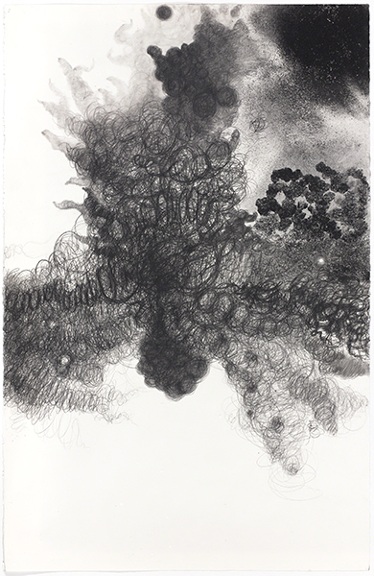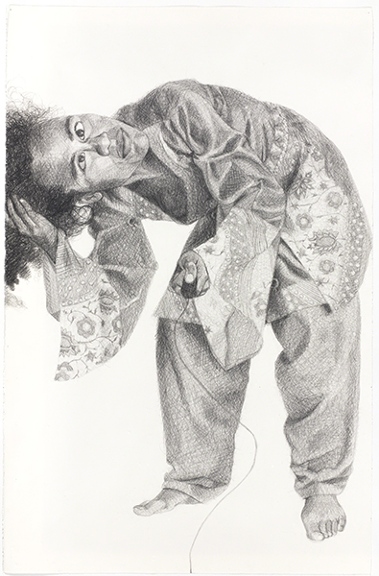Black History Month: Mequitta Ahuja
My celebration of African American artists who have brought beauty into the world continues. This week I present the compelling self-portraits of African American and South Asian American artist Mequitta Ahuja. As an artist, Ahuja examines self-representation in art history, especially that of women artists and artists of color.
 |
| Mequitta Ahuja (born 1976, U.S.), Fount, 2009. Six panel polyptych, waxy chalk on six sheets of white wove paper, overall: 3' 4" x 13' (101.6 × 396.2 cm), each sheet: 40" x 26" (101.6 × 66 cm). Philadelphia Museum of Art. © 2024 Mequitta Ahuja. (PMA-4203) |
Ahuja’s works on paper are complex arrangements of contour lines, hatching, and crosshatching to create realistic and abstract imagery. Intricate crosshatching defines abstract forms between the two self-portraits in Fount. First creating performance pieces, Ahuja photographs herself in costumes and poses. She then combines images from her photographs with abstract forms from her imagination and lived experiences. In Fount, Ahuja depicts herself as a self-sufficient female artist whose creative inspirations flow symbolically from her bowed head, forming fantastic and beautiful shapes in the middle.
Responding to the history of Black hair as a barometer of social and personal consciousness, I make the image of hair both physical and conceptual, showing the psychic proportions hair has in the lives of Black people. I invert the head. Through this disorientation, I signal a shift from the actual to the imagined, concrete realism to abstract thought. In both painting and drawing, I use the space of hair as a vehicle for infinite possibilities of becoming. Proposing imagination as a primary tool of transformation and self-empowerment, my works demonstrate female self-invention and self-representation through the deployment of her own tools.—Mequitta Ahuja artist statement, courtesy of Grantmakers in the Arts Foundation
Translating an artist's personal narrative into a story the viewer can visually understand has challenged artists since the culture "revolutions" of the 1970s. The genre of personal narrative ranges from reserved presentations of the artist's experiences to totally open, deeply personal declarations. Artist may also explore political, gender, or racial issues through their personal narratives. Many artists try to find a middle ground between emphasizing a clear narrative or message and pure visual expression. This is all while striving not to undercut the artistic merit of the work.
Originally from Grand Rapids, Michigan, Ahuja moved to Weston, Connecticut, with her family in the 1980s. She earning a bachelor of arts degree from Hampshire College in Amherst, Massachusetts, in 1998. In 2003, she earned her MFA from the University of Illinois at Chicago. She is now based in Weston and Baltimore, Maryland. Renowned for her self-portraits, Ahuja depicts herself in a myriad of guises, some fictional, some real.
Ahuja calls her work automythography—creating a vision of the self through personal narrative and mythologies derived from personal experiences and cultural heritage. Along with the postmodern principle of personal narrative, Ahuja uses layering to explore identity from a combination of African American, Indian American, and feminist perspectives. The works represent Ahuja's real self drawn from photographs and imagery from her imagination. Historical references to portraits in art history and cultural dress are combined with contemporary styles and abstract forms.
Representation, abstraction, text, graphic flatness, and the illusion of depth are found in Ahuja’s self-portraits. Her artworks embody not only her identity as an artist working in her studio, but also as a person engaged in other activities such as reading, writing, or dreaming. Rather than simply depicting herself standing before the easel, Ahuja creates a broad portrait of the artist’s activities and interests.
Details of panels from Fount:
 |
| Mequitta Ahuja, Fount, second panel, 2009. Six panel polyptych, waxy chalk on six sheets of white wove paper, each sheet: 40" x 26" (101.6 × 66 cm). Philadelphia Museum of Art. © 2024 Mequitta Ahuja. (PMA-4203B) |
 |
| Mequitta Ahuja, Fount, sixth panel, 2009. Six panel polyptych, waxy chalk on six sheets of white wove paper, each sheet: 40" x 26" (101.6 × 66 cm). Philadelphia Museum of Art. © 2024 Mequitta Ahuja. (PMA-4203F) |
Correlations to Davis programs: Explorations in Art 2E Grade 1: 2.1; Explorations in Art 2E Grade 2: 2.3; Explorations in Art 2E Grade 3: 1.1; Explorations in Art 2E Grade 6: 1.9; Exploring Painting 3E: chapter 7 Studio Experience


Comments